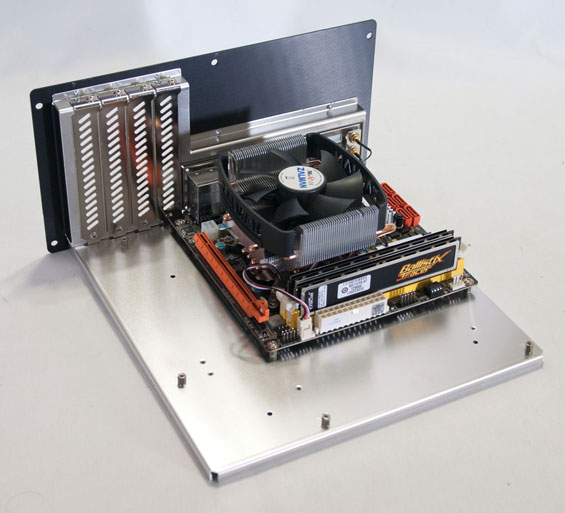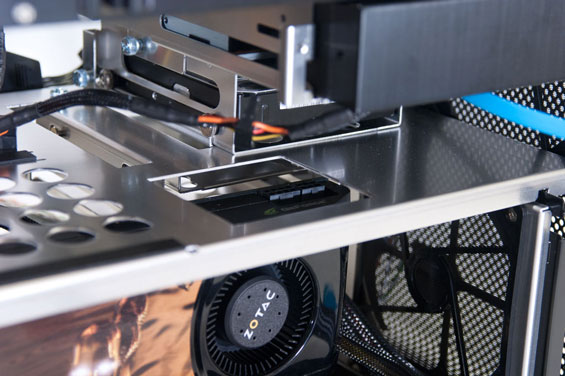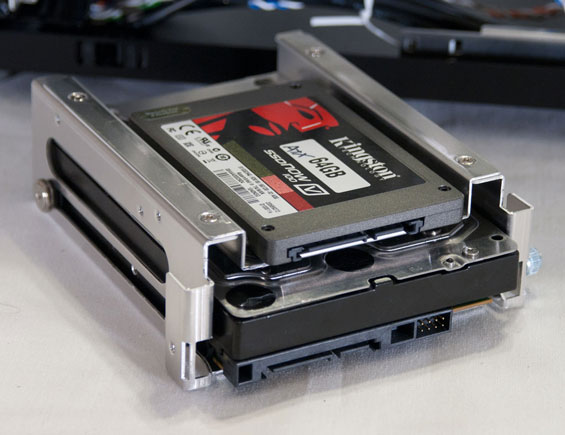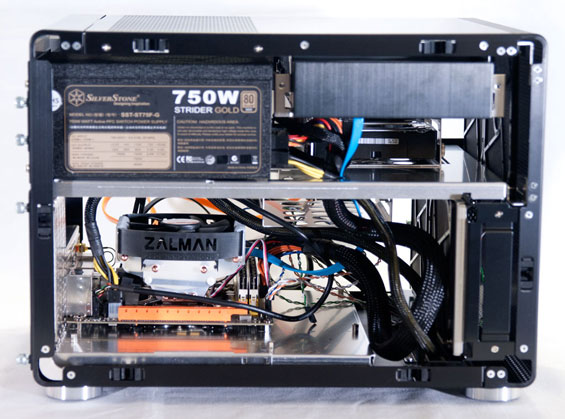Lian Li's PC-V353: Lighter Than Air
by Dustin Sklavos on September 28, 2011 4:30 AM EST- Posted in
- Cases/Cooling/PSUs
- MicroATX
- SFF
- Lian Li
- Mini-Tower
Assembling the Lian Li PC-V353
Lian Li designed the PC-V353's assembly to be tackled essentially in pieces. I have historically endorsed using modular power supplies for any build (to the point where I'm mortified whenever I have to assemble a machine without a modular power supply); in the instance of the PC-V353, I'm about 5% away from making it a requirement.
The PC-V353 breaks down into roughly four parts (five if you're going to argue semantics): the motherboard tray, the drive trays, the power supply mount, and the chassis (which includes the optical drive mount). Because of the nature of the breakdown, it's really in your best interests to wire up each part as best you can before fitting it all together. Since power leads are particularly ornery, that makes a modular power supply that much more vital to assembly in a case like this.

Since the motherboard tray is removable, that part was remarkably easy, though I found the relatively flimsy nature of the tray itself to be a little disconcerting. Everything did come together fine, but it's strange when you're reassuring yourself that it'll work because the rest of the case will have a little give. When I installed the GeForce GTX 580 on the tray, it looked absolutely massive.

Unfortunately, video cards with top-mounted power connectors are liable to be basically hosed when you do install them in the PC-V353, and that's the reason why there are no results for the GTX 580 in the thermal and acoustic testing: the card itself fit fine, but the power connectors were just too thick and there wasn't enough clearance. Lian Li has a cut-out in the top half of the case for routing exactly these power cables, but it didn't line up with our GTX 580, which uses NVIDIA's reference design.

The drives all install in a fairly unique way as well: all of the screws are on rubber-lined runners, and this is true for the 2.5", 3.5" and 5.25" drive mounts. Screws are mounted into the drive first, and then for the 3.5" drive, the drive slides into the rails, and then a thumbscrew locks it into place. Instead of a thumbscrew for the 5.25" drive, it's the fascia. And for the 2.5" drive, there are basically four big holes you drop the screw side into, then push the drive "up" and it locks into place. The system is really quite clever. Again, though, you'll want to wire the drives first. Routing the 5.25" drive's cables requires some doing; you'll want to basically slide them in between the gap between the opposite 5.25" drive bay's fascia and the chassis itself.
Finally, the power supply should go in last and quarters are going to be cramped. If you've been doing this properly and used a modular power supply, your power leads will be connected to the components first so they can be routed up to the power supply at the last stop. If you've been careful, everything should come together reasonably well.

I have to be honest, I'm just not a fan of how the PC-V353 comes together. It feels like it's too unusual, and Lian Li just doesn't make the best use of empty space the way the similar SilverStone does in the Temjin TJ08-E. I have an AVADirect desktop in house that's installed in a Lian Li PC-V354, and honestly that design looks to be a little more sensible than this one. The lack of clearance for the video card's power cables makes all of that case depth feel pointless, and side mounting the optical drive just doesn't seem at all necessary. On top of that, I found the optical drive bay button doesn't line up with our test drive at all. That's not unusual with designs like these, but it makes me wonder why more enclosure designers don't just design a larger button (either externally or internally) that's able to cover the gamut of optical drive eject button placement.
















57 Comments
View All Comments
Dustin Sklavos - Wednesday, September 28, 2011 - link
It never ceases to amaze me what some people find offensive.IlllI - Wednesday, September 28, 2011 - link
i find your post offensive!!i DEMAND you change it because i find it offensive! you have lost all credibility with me because you spoke your mind!
actually i agree. some people get too damn butt-hurt over the littlest things
JarredWalton - Wednesday, September 28, 2011 - link
+1cjmurph - Wednesday, September 28, 2011 - link
"but surprisingly they don't advertise what may be one of its more interesting aspects: the enclosure is comprised almost entirely of aluminum"Umm, it's a Lian Li case dude, what else is it going to be made out of, chicken feet?
aznofazns - Wednesday, September 28, 2011 - link
That line had me confused as well. Anyone who knows anything about Lian Li cases should realize that the all-aluminum construction is practically their main selling point.But the part that bothered me was the conclusion. "It's a nice and unique piece of aluminum, tremendously light and easy to move, but this case honestly would fare a lot better with fans." Dustin, I think you're missing the point of this case. It's designed to be a silent case, so it'd probably be wise to use a fanless PSU (Seasonic SS-400FL, anyone?), large, passively cooled CPU heatsink (or a really quiet one like the Scythe Big Shuriken or Zipang 2), and a passively cooled graphics card. Or better yet, install a Llano A8 chip.
I do agree that Lian Li didn't make the best use of space in the V353, as with most/all of the V3xx series, but the end result is a pretty slick looking microATX rig.
JarredWalton - Wednesday, September 28, 2011 - link
Having lots of ventilation (and no sound dampening) flies in the face of building a silent PC.aznofazns - Wednesday, September 28, 2011 - link
Lack of sound dampening seems irrelevant when the components inside are silent, don't you think?aznofazns - Wednesday, September 28, 2011 - link
Just to hammer this point home, read Lian Li's own description of the PC-V353:http://www.lian-li.com/v2/en/product/product06.php...
"The PC-V353 is designed to be a silent case.
To use lots vents instead of fans to cool components."
JarredWalton - Wednesday, September 28, 2011 - link
How about "quiet case" as opposed to silent, because small and compact with no sound dampening but still using a CPU fan (necessary given the cramped quarters) means that this won't be "silent".aznofazns - Wednesday, September 28, 2011 - link
Well it depends on what components you're using.For example, a low power Zacate, Llano A4, or dual core Sandy Bridge chip would be able to get by with a large, passive heatsink. The ventilated case would be enough to keep those chips from overheating. With no case fans, a fanless PSU, and an SSD, the system would literally be silent (save for possible capacitor squeal).
On the other hand, a higher power CPU/APU could use a heatsink with a large, low rpm fan. In that case it would be "quiet," but having case fans would still add to the noise.
Either way, Lian Li designed this case to be cooled passively.